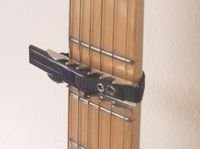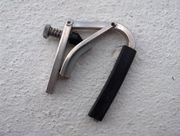
A basic guitar capo
A capo (short for capotasto, Italian for "head of fretboard") is a device used for shortening
the strings, and hence raising the pitch, of a stringed instrument such as a guitar, mandolin or banjo. There
are several different styles of capo available, utilizing a range of mechanisms, but most use a rubber-covered
bar to hold down the strings, fastened with a strip of elastic or nylon, a cam-operated metal clamp, or another
device.
The use of a capo is considered by some people to be a crutch for technically inferior players. While it can be
used for this purpose (for example, allowing a novice guitarist to play chords in the relatively difficult key
of A flat by playing the much simpler chord shapes for the key of G), it also facilitates making use of the
instrument's natural qualities in certain keys and allows for the use of techniques and sounds that would otherwise
be unavailable.
With 12-string guitars a capo used to be necessary to play in tune with a six-string because manufacturers would
strongly recommend that the instrument not be tuned above a tone below standard guitar tuning to reduce
stresses on the neck. Modern 12-strings can be tuned up to pitch with ultra light gauge strings, but many players
still prefer to tune a tone lower and use a capo to play in tune with six-string or bass guitars.

A Shubb capo which uses a cam-operated clamp
Because of the different techniques and chord voicings available in different keys, the same piece may sound very
different played in D or played in C with a capo at the second fret (at the same actual pitch). Additionally, the
timbre of the strings changes as the scale length is shortened, suggesting other short-scaled stringed instruments
such as the mandolin. Therefore the use of a capo is as much a matter of artistic expression as of technical
expediency.
The use of a capo also obviates the need to learn a song in several different keys if accompanying singers who
sing at different pitches.
For guitar playing, some styles such as flamenco and British/American folk music make extensive use of the capo,
while it is used very rarely, if at all, in other styles such as classical and jazz playing.
Variations in the design of capos allow a range of advantages to players. A capo with two rollers, one over the
neck and one under, facilitates quick key changes in the middle of tunes or sets. This is a particular advantage
in playing Irish music on the guitar, as it enables the player to move quickly between keys without sacrificing
drone strings. Clamp-style capos fitted from the side of the neck (as distinct from those which encircle it) can
be placed so as to leave one or two strings open. This gives some of the advantages of variant tunings (such as
a capoed dropped D), without requiring a change in fingering of chords above the capo.
One of the more radical developments in capo design in recent years is the partial capo made by the Third Hand
Capo Company. This model allows each string to be stopped individually, and can be used in conjunction with other
capos, either of the same type or of conventional design. In theory this puts a vast number of variant tunings at
the player's disposal. In practice it is most often placed either on the 2nd fret of the 3rd, 4th and 5th strings
(producing the effect of DADGAD tuning raised two semitones), or on the 2nd fret of the 2nd, 3rd and 4th strings
(open A major). Again, this requires no change of fingering above the capo. A little experimentation with the two
methods of producing variant tunings (partial capo or actual retuning) will show that each has its own advantages.
The five-string banjo, with its short fifth string, poses a particular problem for using the capo. For many years
now it has been possible to buy a specialised fifth-string capo, consisting of a narrow metal strip fixed to the
side of the neck of the instrument, with a sliding stopper for the string.
This article is licensed under the GNU Free Document License
It uses material from the Wikipedia article - Capo
|
